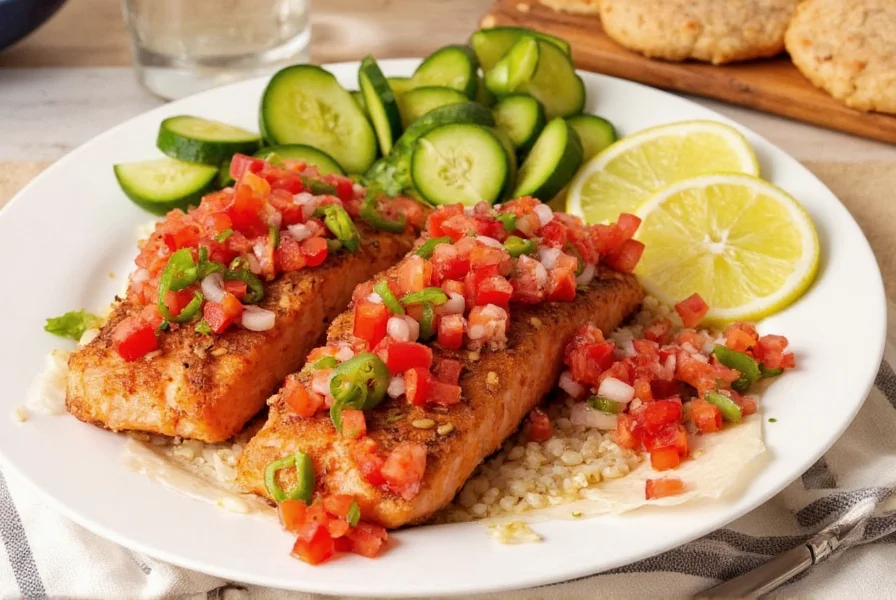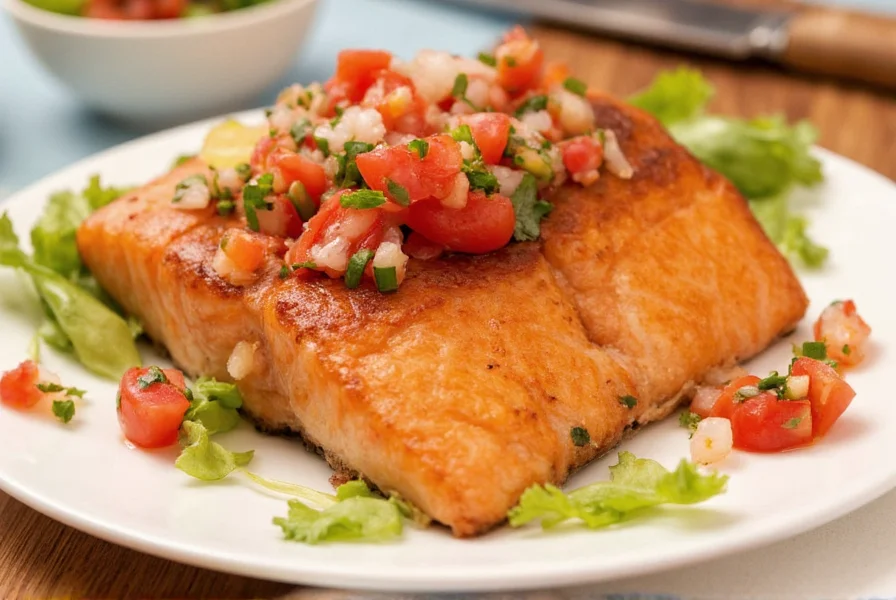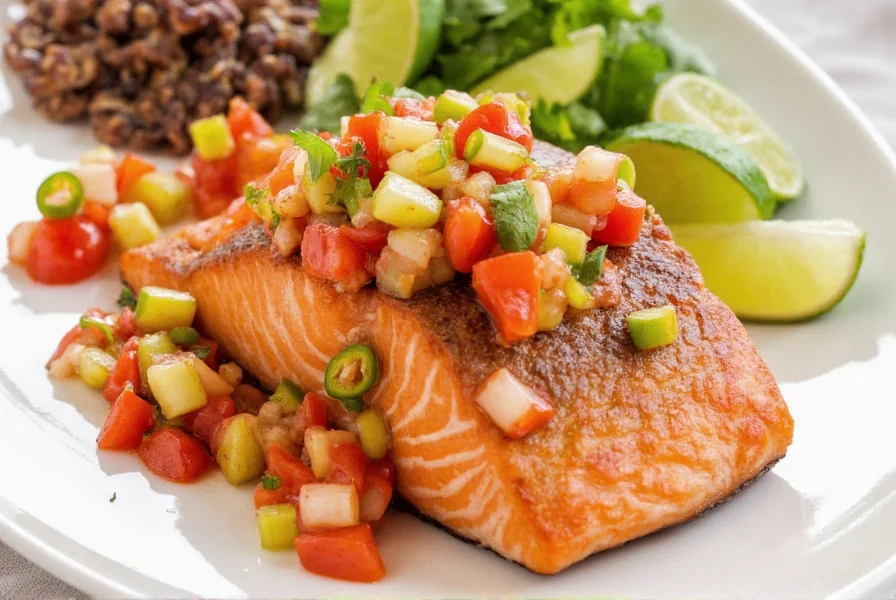Here's a simple step-by-step guide to making delicious salsa salmon:
- Prepare the ingredients: fresh salmon fillets, ripe tomatoes, onions, cilantro, jalapeños, lime juice, and optional ingredients like avocado or mango.
- Clean and dry the salmon fillets: pat dry with paper towels and season with salt and pepper.
- Prepare the salsa: dice tomatoes, onions, jalapeños, and cilantro. Mix with lime juice and optional ingredients like avocado or mango.
- Cook the salmon: for baking, preheat oven to 375°F (190°C) and bake for 12-15 minutes until internal temperature reaches 145°F (63°C). For pan-searing, cook 4-6 minutes per side in a hot skillet with a little oil.
- Top and serve: place the cooked salmon on a plate and top with fresh salsa. Serve immediately for best texture and flavor.
Table of Contents
- Step-by-Step Instructions
- In-Depth Explanation of Salsa Salmon
- Buying Guide for Salsa Salmon Ingredients
- Conclusion
- Frequently Asked Questions
Step-by-Step Instructions
Follow these simple steps to make perfect salsa salmon:
- Prepare the ingredients: fresh salmon fillets, ripe tomatoes, onions, cilantro, jalapeños, lime juice, and optional ingredients like avocado or mango.
- Clean and dry the salmon fillets: pat dry with paper towels and season with salt and pepper.
- Prepare the salsa: dice tomatoes, onions, jalapeños, and cilantro. Mix with lime juice and optional ingredients like avocado or mango.
- Cook the salmon: for baking, preheat oven to 375°F (190°C) and bake for 12-15 minutes until internal temperature reaches 145°F (63°C). For pan-searing, cook 4-6 minutes per side in a hot skillet with a little oil.
- Top and serve: place the cooked salmon on a plate and top with fresh salsa. Serve immediately for best texture and flavor.
In-Depth Explanation of Salsa Salmon
Salsa salmon combines the fresh, tangy flavors of salsa with the rich, flaky texture of salmon. This dish works because the acidity of the salsa cuts through the richness of the fish, creating a balanced and refreshing meal. The key to success is using fresh, high-quality ingredients and proper cooking techniques.
The USDA recommends cooking salmon to an internal temperature of 145°F (63°C) to ensure food safety while maintaining optimal texture. This temperature range preserves moisture and flavor while eliminating potential pathogens.

Buying Guide for Salsa Salmon Ingredients
| Ingredient | Key Features | Quality Indicators | Cooking Recommendations |
|---|---|---|---|
| Salmon | Firm texture, mild flavor, high in omega-3 fatty acids | Shiny skin, firm flesh, no fishy odor | Bake at 375°F (190°C) for 12-15 minutes or pan-sear 4-6 minutes per side |
| Tomatoes | Juicy, slightly acidic, full of flavor | Firm but slightly soft when squeezed, vibrant color | Use ripe, in-season tomatoes for best flavor |
| Cilantro | Bright, citrusy, aromatic | Vibrant green leaves, crisp stems, no yellowing | Add fresh just before serving to preserve flavor |
| Jalapeños | Mild to medium heat, slightly sweet and peppery | Smooth skin, firm texture, heavy for size | Remove seeds for milder heat; use gloves when handling |
| Lime Juice | Tangy, bright, zesty | Heavy for size, smooth skin, no soft spots | Use fresh juice; avoid bottled lime juice for best flavor |

Conclusion
Salsa salmon is a healthy, flavorful dish that combines the best of both worlds: the rich nutrition of salmon and the fresh vibrancy of salsa. By following these simple steps and using quality ingredients, you can create a restaurant-quality meal at home in under 30 minutes.
This dish is perfect for weeknight dinners, summer barbecues, or when you want a healthy meal that doesn't compromise on flavor. The combination of protein, healthy fats, and fresh vegetables makes it a well-rounded meal that satisfies both taste and nutrition needs.
Frequently Asked Questions
How long should I cook salmon for salsa salmon?
Cook salmon until it reaches an internal temperature of 145°F (63°C) as recommended by the USDA. For baking, this typically takes 12-15 minutes at 375°F (190°C). For pan-searing, cook 4-6 minutes per side. Always add salsa after cooking to preserve its fresh texture and vibrant colors.
Can I use store-bought salsa instead of making it from scratch?
Yes, but choose a fresh, refrigerated salsa with simple ingredients. Avoid overly processed varieties with artificial preservatives. For optimal flavor, drain excess liquid from store-bought salsa before topping your cooked salmon. Look for salsas with tomatoes, onions, cilantro, jalapeños, and lime juice as primary ingredients.
What are the best side dishes to serve with salsa salmon?
Popular pairings include cilantro-lime rice, grilled asparagus, avocado salad, or black bean corn salad. For low-carb options, serve over zucchini noodles or a bed of mixed greens. The acidity of the salsa complements creamy sides like avocado or Greek yogurt-based sauces.
How do I store leftover salsa salmon?
Store cooked salmon and salsa separately in airtight containers for up to 2 days. Reheat salmon gently in the oven at 275°F (135°C) to prevent drying out, then top with fresh salsa. Never reheat salmon covered with salsa as it will become mushy and lose its fresh texture.
Is salsa salmon healthy for regular consumption?
Yes, it's an excellent source of omega-3 fatty acids, lean protein, and antioxidants from fresh vegetables. A typical 6-ounce serving provides about 30g protein and 15g healthy fats. For a balanced meal, pair with whole grains and additional vegetables to meet daily fiber requirements.











 浙公网安备
33010002000092号
浙公网安备
33010002000092号 浙B2-20120091-4
浙B2-20120091-4